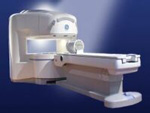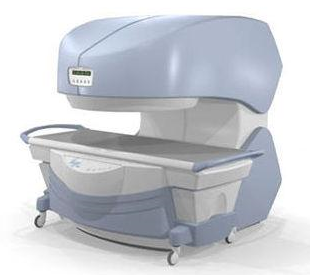 | Info
Sheets |
| | | | | | | | | | | | | | | | | | | | | | | | |
 | Out-
side |
| | | | |
|
| | | | |
Result : Searchterm 'Dynamic Scan' found in 1 term [ ] and 2 definitions [ ] and 2 definitions [ ], (+ 16 Boolean[ ], (+ 16 Boolean[ ] results ] results
| 1 - 5 (of 19) nextResult Pages :  [1] [1]  [2 3 4] [2 3 4] |  | |  | Searchterm 'Dynamic Scan' was also found in the following services: | | | | |
|  |  |
| |
|
Fast gradient echo sequences are used to study dynamic processes with time periods on the order of a second and allow continuous monitoring of most physiologic motions. A common use of dynamic scanning is the investigation of the time course of tissue contrast after injection of a paramagnetic contrast agent. | |  | | | | • Share the entry 'Dynamic Scanning':    | | |
• View the NEWS results for 'Dynamic Scanning' (1).
| | | | |  Further Reading: Further Reading: | News & More:
|
 |
Static and Dynamic Magnetic Resonance Imaging in Female Pelvic Floor Dysfunction: Correlation With Pelvic Organ Prolapse Quantification
Sunday, 10 September 2023 by www.cureus.com |  |  |
RSNA: Three Time-Point, Dynamic, Contrast-Enhanced Magnetic Resonance Imaging Can Help Rule Out Prostate Cancer
Tuesday, 2 December 2003 by www.docguide.com |  |  |
Deep dive into the use of dynamic MRI for pelvic organ prolapse
Wednesday, 15 June 2022 by www.contemporaryobgyn.net |  |  |
4D-Fueled AI with DCE-MRI Improves Breast Lesion Characterization
Friday, 26 February 2021 by www.diagnosticimaging.com |  |  |
Evaluating the Relationship Between Dynamic Contrast-Enhanced MRI (DCE-MRI) Parameters and Pathological Characteristics in Breast Cancer
Thursday, 11 June 2020 by www.docwirenews.com |  |  |
The Effects of Breathing Motion on DCE-MRI Images: Phantom Studies Simulating Respiratory Motion to Compare CAIPIRINHA-VIBE, Radial-VIBE, and Conventional VIBE
Tuesday, 7 February 2017 by www.kjronline.org |  |  |
Optimal k-Space Sampling for Dynamic Contrast-Enhanced MRI with an Application to MR Renography
Thursday, 5 November 2009 by www.ncbi.nlm.nih.gov |  |  |
MRI Scans May Improve PCa Recurrence at Low PSA Levels
Tuesday, 3 May 2011 by www.renalandurologynews.com |  |  |
Average arterial input function for quantitative dynamic contrast enhanced magnetic resonance imaging of neck nodal metastases
Tuesday, 7 April 2009 by 7thspace.com |
|
| |
|  | |  |  |  |
| |
|
Contrast enhanced MRI is a commonly used procedure in magnetic resonance imaging. The need to more accurately characterize different types of lesions and to detect all malignant lesions is the main reason for the use of intravenous contrast agents.
Some methods are available to improve the contrast of different tissues. The focus of dynamic contrast enhanced MRI (DCE-MRI) is on contrast kinetics with demands for spatial resolution dependent on the application. DCE- MR imaging is used for diagnosis of cancer (see also liver imaging, abdominal imaging, breast MRI, dynamic scanning) as well as for diagnosis of cardiac infarction (see perfusion imaging, cardiac MRI). Quantitative DCE-MRI requires special data acquisition techniques and analysis software.
Contrast enhanced magnetic resonance angiography (CE-MRA) allows the visualization of vessels and the temporal resolution provides a separation of arteries and veins. These methods share the need for acquisition methods with high temporal and spatial resolution.
Double contrast administration (combined contrast enhanced (CCE) MRI) uses two contrast agents with complementary mechanisms e.g., superparamagnetic iron oxide to darken the background liver and gadolinium to brighten the vessels. A variety of different categories of contrast agents are currently available for clinical use.
Reasons for the use of contrast agents in MRI scans are:
•
Relaxation characteristics of normal and pathologic tissues are not always different enough to produce obvious differences in signal intensity.
•
Pathology that is sometimes occult on unenhanced images becomes obvious in the presence of contrast.
•
Enhancement significantly increases MRI sensitivity.
•
In addition to improving delineation between normal and abnormal tissues, the pattern of contrast enhancement can improve diagnostic specificity by facilitating characterization of the lesion(s) in question.
•
Contrast can yield physiologic and functional information in addition to lesion delineation.
Common Indications:
Brain MRI : Preoperative/pretreatment evaluation and postoperative evaluation of brain tumor therapy, CNS infections, noninfectious inflammatory disease and meningeal disease.
Spine MRI : Infection/inflammatory disease, primary tumors, drop metastases, initial evaluation of syrinx, postoperative evaluation of the lumbar spine: disk vs. scar.
Breast MRI : Detection of breast cancer in case of dense breasts, implants, malignant lymph nodes, or scarring after treatment for breast cancer, diagnosis of a suspicious breast lesion in order to avoid biopsy.
For Ultrasound Imaging (USI) see Contrast Enhanced Ultrasound at Medical-Ultrasound-Imaging.com.
See also Blood Pool Agents, Myocardial Late Enhancement, Cardiovascular Imaging, Contrast Enhanced MR Venography, Contrast Resolution, Dynamic Scanning, Lung Imaging, Hepatobiliary Contrast Agents, Contrast Medium and MRI Guided Biopsy. | | | | | | | | | | |
• View the DATABASE results for 'Contrast Enhanced MRI' (14).
| | |
• View the NEWS results for 'Contrast Enhanced MRI' (8).
| | | | |  Further Reading: Further Reading: | | Basics:
|
|
News & More:
|  |
FDA Approves Gadopiclenol for Contrast-Enhanced Magnetic Resonance Imaging
Tuesday, 27 September 2022 by www.pharmacytimes.com |  |  |
Effect of gadolinium-based contrast agent on breast diffusion-tensor imaging
Thursday, 6 August 2020 by www.eurekalert.org |  |  |
Artificial Intelligence Processes Provide Solutions to Gadolinium Retention Concerns
Thursday, 30 January 2020 by www.itnonline.com |  |  |
Accuracy of Unenhanced MRI in the Detection of New Brain Lesions in Multiple Sclerosis
Tuesday, 12 March 2019 by pubs.rsna.org |  |  |
The Effects of Breathing Motion on DCE-MRI Images: Phantom Studies Simulating Respiratory Motion to Compare CAIPIRINHA-VIBE, Radial-VIBE, and Conventional VIBE
Tuesday, 7 February 2017 by www.kjronline.org |  |  |
Novel Imaging Technique Improves Prostate Cancer Detection
Tuesday, 6 January 2015 by health.ucsd.edu |  |  |
New oxygen-enhanced MRI scan 'helps identify most dangerous tumours'
Thursday, 10 December 2015 by www.dailymail.co.uk |  |  |
All-organic MRI Contrast Agent Tested In Mice
Monday, 24 September 2012 by cen.acs.org |  |  |
A groundbreaking new graphene-based MRI contrast agent
Friday, 8 June 2012 by www.nanowerk.com |
|
| |
|  | |  |  |  |
| |
|
Primovist™ (U.S brand name Eovist®) is a highly specific MRI contrast agent for the imaging, detection and characterization of liver conditions, including liver tumors, cysts, as well as other malignant and benign lesions. It is a water-soluble ethoxybenzyl derivative of Gd-DTPA. This compound is taken up by the hepatocytes (approximately 30% of the dose goes to the hepatocytes) and is equally excreted renal and biliary in humans.
Primovist™ brightens the signal of T1 weighted MR images immediately after contrast administration.
Dynamic scanning and imaging of the accumulation phase (best after 20 min.) can also be performed after bolus injection of Primovistâ„¢. The hepatocytes uptake will increase the signal intensity of normal liver parenchyma. This results in improved lesion-to-liver contrast because malignant tumors (metastases, the majority of hepatocellular carcinomas) do not contain either hepatocytes or their functioning is hampered.
WARNING:
Gadolinium-based contrast agents increase the risk for nephrogenic systemic fibrosis (NSF) in patients with acute or chronic severe renal insufficiency (glomerular filtration rate less than 30 mL/min/1.73m 2), or acute renal insufficiency of any severity due to the hepato-renal syndrome or in the perioperative liver transplantation period. Drug Information and Specification T1, Predominantly positive enhancement PHARMACOKINETIC 50% hepatobiliary, 50% renal excretion DOSAGE 12,5 - 25 µmol/kg PREPARATION Finished product DEVELOPMENT STAGE for sale DO NOT RELY ON THE INFORMATION PROVIDED HERE, THEY ARE
NOT A SUBSTITUTE FOR THE ACCOMPANYING PACKAGE INSERT! Distribution Information TERRITORY TRADE NAME DEVELOPMENT
STAGE DISTRIBUTOR | |  | |
• View the DATABASE results for 'Primovist™' (7).
| | | | |  Further Reading: Further Reading: | Basics:
|
|
News & More:
| |
| |
|  |  | Searchterm 'Dynamic Scan' was also found in the following services: | | | | |
|  |  |
| |
|

From GE Healthcare;
the Signa Ovation™ is a patient-friendly open MRI scanner designed not only to handle a typical patient mix, but to accommodate larger patients, patients who are claustrophobic, and others who have difficulty tolerating the close quarters of conventional MR machines.
Device Information and Specification CLINICAL APPLICATION Whole body Standard: SE, IR, 2D/3D GRE and SPGR, 2D/3D TOF, 2D/3D FSE, 2D/3D FGRE and FSPGR, SSFP, FLAIR, EPI, optional: 2D/3D Fiesta, true chem sat, fat/water separation, single shot diffusion EPI, line scan diffusionIMAGING MODES Localizer, single slice, multislice, volume, fast, POMP, multi slab, cine, slice and frequency zip, extended dynamic range, tailored RF TR 1.3 to 12000 msec in increments of 1 msec TE 0.4 to 2000 msec in increments of 1 msec 2D: 1.4mm - 20mm 3D: 0.2mm - 20mm 0.08 mm; 0.02 mm optional POWER REQUIREMENTS 200 - 480, 3-phase MAX. GRADIENT AMPLITUDE 19 mT/m | |  | |
• View the DATABASE results for 'Signa Ovation™' (2).
| | | | |
|  | |  |  |  |
| |
|

From
Millennium Technology Inc.
This open C-shaped MRI system eases patient comfort and technologist maneuverability. This low cost scanner is build for a wide range of applications. The Virgo™ patient table is detachable and moves on easy rolling castors. Able to accommodate patient weights up to 160 kg, the tabletop has a range of motion of 30 cm in the lateral direction and 90cm in the longitudinal direction. Images generated with this scanner can only be viewed (without data loss) on Millennium's proprietary viewing software.
Device Information and Specification CLINICAL APPLICATION Whole body Head, Body, Neck, Knee, Shoulder,
Spine, Wrist, Breast, Extremity, Lumbar Spine, TMJ
IMAGING MODES Localizer, single slice, multislice, volume, fast, POMP, multi slab, cine, slice and frequency zip, extended dynamic range, tailored RF | |  | | | |
|  | |  |  |
|  | 1 - 5 (of 19) nextResult Pages :  [1] [1]  [2 3 4] [2 3 4] |
| |
|
| |
 | Look
Ups |
| |